Do you collect a lot of stuff? Is it hard to go shopping for even more stuff when you don’t know what stuff you already have back at home? Avid collectors of books, CDs, DVDs, games, etc. now have a new tool to help them manage their stuff more effectively. It’s the Groqit Personal Inventory Management System. Put this device in your pocket when you go shopping and it will tell you if the item you’re about to buy is already in your collection at home. Let’s learn more about it…
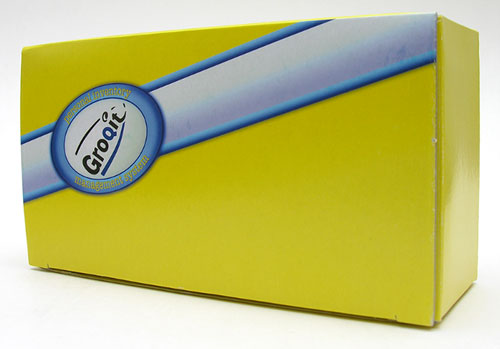
The Groqit (say it like grock’et, which rhymes with rocket) comes packaged in a cheery Yellow box.
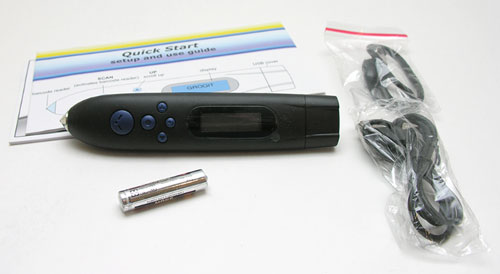
Package Contents
Groqit scanner
AAA battery
USB extension cable
Handstrap
Quick start guide
Manual
What is the Groqit?
It’s a small pocketable device that you can use to scan and remember the barcodes on your books, DVDs, CDs, and other items. You can then take it with you when you go shopping. When you find an item that you’re not sure if you already own, you just put the Groqit in check mode, scan the barcode on the item, and it will report back if it’s in your inventory.

The Groqit is a six inch long barcode scanner, with five buttons and a 2 line backlit display.
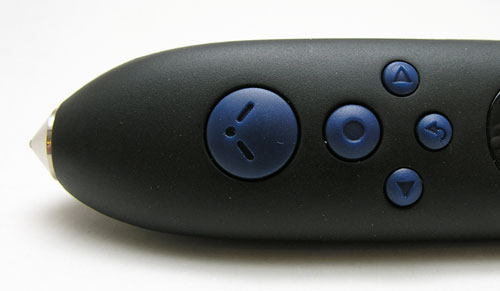
You can scroll up and down through the on screen menu items by using the up / down arrow buttons. Pressing the larger middle enter button selects an item, while pressing the curled arrow backs up one menu level. The largest button initiates the scanning feature.
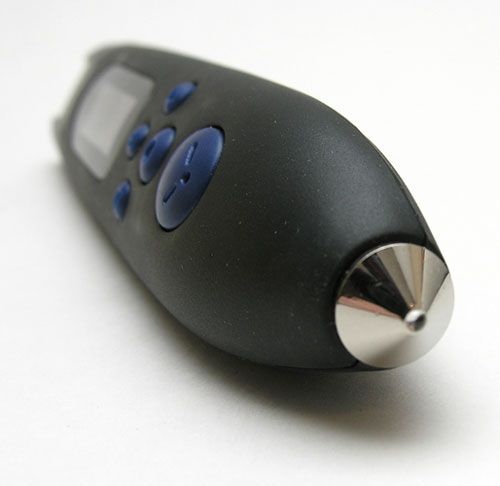
The scanning tip glows red when in scanning mode. I should mention that the Groqit does not scan like the handheld scanners that you see at retail stores and supermarkets. You don’t just point the tip at a barcode and press a button to scan the code. Nope, the Groqit has to be swiped across the actual barcode. More about that in a minute.

The end opposite the scanning tip pulls off to reveal a USB connector. You can either plug the Groqit directly into a free port on your computer, or you can use the included USB extension cable to connect it. Once connected, you use a small application on your PC or Mac to sync the scanned data to the web.
How do you use it?
Just install the included AAA battery and then hold one of the five buttons for two seconds to power on the device.

You’ll then be presented with a list of pre-set categories that include Books, Example1, Example2, Games, Music, Video, Wishlist and Househol. These categories can be renamed, removed or added to by connecting the Groqit to your PC or Mac and the web. You can add up to 510 categories to the device. Naming the categories might be challenging due to the 8 character limit.


Say that you want to add a book to the books category. You scroll to that category and press the enter button. From there you have three options. You can either add a new barcode, check to see if it’s already in your inventory by doing a check or deleting a barcode. Let’s add a barcode…


When you select Add Barcode, you then have the option to scan the code, key it in manually or do multiple scans. Choosing the scan option will then wait for you to press the large scan button. At that point, you have about 2 seconds to swipe the scanner across the barcode on the book, CD, DVD, etc.
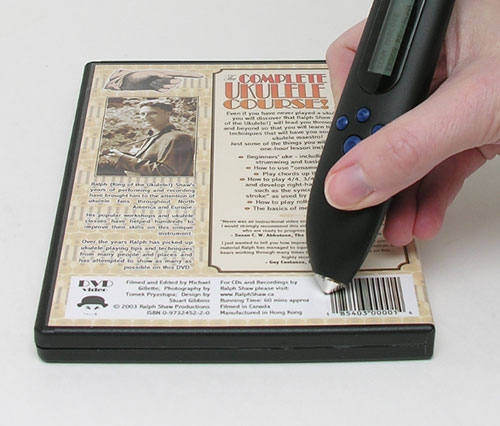
You have to make physical contact with the scanning tip as you swipe it across the barcode. You also have to do it FAST. I mean really fast… like striking a match. If that sounds easy, let me tell you, it isn’t… It takes quite a bit of practice.

If the scan is successful, you’ll hear one long beep. If the scan is unsuccessful, you’ll see the message show in the image above and will also hear two beeps. You can then press the scan button and try again. It took me probably 10 tries before I was able to record my first scan. After at least 100 scanning tries, I’ve gotten better at it, but for me it is still hit and miss. I think maybe that I lack some necessary scanning gene, so I gave the Groqit to someone else to try and they fared a little better. Listening to an endless string of beep-beeps became quite frustrating to say the least. One nice feature is the ability to turn off the beeps…


When a scan is successful, you’ll will see the code and can then press a button to search for the code. If it is already in your inventory for that category, it will tell you. Otherwise, you can add it. The Groqit has an internal flash drive memory of 128 MB which can hold about 3.5 million of barcodes.
Of course, the whole idea is to scan all of your items at home and then when you go shopping, you can use the scanner to check barcodes for things you’re about to purchase.

By using the check barcode feature, you will find out if that item is already in your inventory.
Besides the finicky scanning action, there are a couple other caveats to this product. The major one is the fact that you can’t scan CD barcodes through the plastic jewel cases. It just won’t work because the barcode itself is too far away (because of the thickness of the plastic case) from the tip of the scanner. This a real bummer for people that would use the Groqit primarily for managing a CD collection.
Another problem is that you have to pay attention to the categories that you’re adding barcodes to. If you screw up and put a bunch of your books in the music category, when you go to do a search at a store, it won’t find an existing code if you’re not searching in the correct category. I think there should be an All category that would allow you to search every category for a code. It’s just too easy to accidently add new codes to the wrong categories.
I should mention that it is possible to manually add and check a barcode instead of using the scanning tip. You can use the up / down arrows to insert the numbers of the barcode. It’s a bit tedious and time consuming, but it is doable if you have infinite patience.
Backing up and syncing the data
Once you’ve scanned your collection of a bazillion CDs, DVDs, Books, etc., you probably want a method of backing up that data right? Luckily, there’s a small application for Windows and Macs that you can download to give you that ability. You’ll also need this app to sync your data to the Groqit website.
The application (I only tested the Mac version), is quite basic. You can save multiple dated backups and can restore them if needed. You can also sync the data to the web. Unfortunately, the local application gives you absolutely no way to manipulate the data. To do that, you have to sign up for an account on the Groqit website.
Signing up will get you a 30 day trial of their paid basic services. The free services include the ability to backup your data, but not restore it to the device. You can already do both with the local application though. You don’t have to sync your data with the website, but the advantage is that extra information will be added to your inventory list, turning the basically useless barcode number into something that a human can understand. Some of the extra info that is offered includes:
Books: Author | Title | ISBN | UPC | Publisher
Pop Music: Album title | Artist name | UPC | Composer
Classical Music: Album title | Performer names | Work titles | Composers | UPC
Movies: Titles | Genre | Release date | UPC
Games: Game title | Platform | Accessory title | UPC
This information will only be added if that item is in the Groqit database. I scanned several new DVDs that I owned and some were there and others were not. You can add the info yourself though… if you can figure out what info goes with what barcode.
The web services also allow you to create wish lists and buddy lists so that your friends (even if they don’t own a Groqit) can check to see if you own an item before buying it for you. Also, your friends can create a free account on the site and create their own list of items, so that you can use the Groqit when you go shopping for them. Even people that don’t own a Groqit can reference people’s wishlists to help them figure out what items they can buy without duplication.
The paid basic membership ($4.95 after the 30 day trial) gives you the ability to both backup and restore data to the device and export your data in the form of CSV files.
Conclusion
The Groqit Personal Inventory Management System is an interesting tool for someone that enjoys collecting things. I can definitely see its potential benefits, but for me it really didn’t work all that well. The issue that it can’t scan through the plastic jewel cases that CDs are packaged in leaves out one big group of collectors. Yes, you can remove the barcode portion of the CD packaging from the case, and scan it that way. But that won’t help you if you’re in a store and want to do a lookup to see if you already own that particular CD. And yes, you can manually enter the barcode numbers, but I really don’t see anyone doing that more than a couple of times before just deciding that it’s more trouble than it’s worth. At $95.00, this tool needs a bit more work both hardware and software-wise, before I would recommend it for primetime.
ESR Upgraded for MagSafe Wallet, 5 Card Holder, RFID Blocking, Magnetic Wallet for iPhone with Adjustable Stand, Slim for iPhone 17/16/15/14/13/12 Series, Not for 13/12 Mini, Vegan Leather, Black
33% OffQYQBOON Mag-Safe Wallet Magnetic Wallet for Phone Lightweight Magnetic Phone Pouch Stand Adjustable Leather Mag-Safe Card Holder for iPhone 17/16/15/14/13/12 Series, Not for iPhone 13/12 Mini (Black)
32% OffProduct Information
| Price: | 95.0 |
| Manufacturer: | Groqit |
| Retailer: | Groqit |
| Pros: |
|
| Cons: |
|

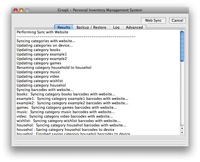
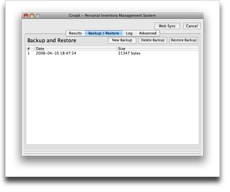
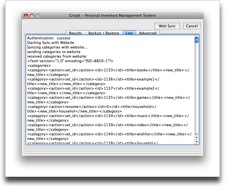
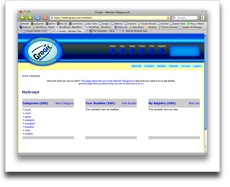
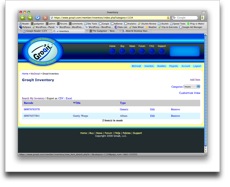


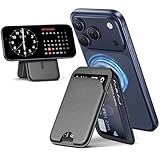
Gadgeteer Comment Policy - Please read before commenting
Some responses from Groqit to specifics in the review:
“The application…is quite basic. …Unfortunately, the local application gives you absolutely no way to manipulate the data. To do that, you have to sign up for an account on the Groqit website.”
-We wanted to make sure people know that signing up for the account is absolutely free.
Most of our web services are free and a person can use them without buying a Groqit. Paid membership give you more of everything that’s free, plus additional capabilities.
“The web services also allow you to create wish lists and buddy lists so that your friends (even if they don’t own a Groqit) can check to see if you own an item before buying it for you.”
—The FREE web services:
This is a really important social aspect of the Groqit site. Since anyone can become a member and use the free services, your Groqit Buddies can be any of your friends. Having the device is great for portability (and naturally we do want people to buy them) but we figure the device is a lot more valuable if you’re able to have all your friends’ wishlists for when you go shopping. Or have the list of all your nephew’s games (for instance) so even if he has 50 of them, and you can’t remember what they are, you can get him a surprise he doesn’t have.
Here is a link to the “What do I get FREE When I don’t buy anything?” page
“Even people that don’t own a Groqit can reference people’s wishlists to help them figure out what items they can buy without duplication.”
— This is part of the Groqit Buddies option. It is absolutely private and secure. You invite the friends you wish to share with, and choose which lists to share with them; the other party must agree via email before lists are shared.
“Signing up will get you a 30 day trial of their basic paid services.”
— Signing up will also get you absolutely free services!
The online tools make list-creation easier by filling in a lot of information for you automatically. For instance, when you type in a Book Title, it will offer to fill in Author, plus UPC and ISBN. Or if you type in the ISBN it will give back Title and Author from the site’s book database. The site fills in about 3/4 of the information. This drudgery-reduction can make an otherwise fearsome challenge far less daunting.
The Groqit site readily translates barcodes to product information, of course, as that’s the preferred way of entering data.Â
The site has data already there, on its servers, which makes for speedy results. The site stores information on millions of books, movies, games and CDs. (In comparison, there is software for sale that goes out and searches the web for information, which is time consuming and less accurate.)Â
You can store your lists securely on Groqit’s site. This too is free. If a catastrophe happens, you can retrieve that data for insurance purposes.
You can download your lists to print out. Or you might decide to get the Groqit device and have your lists in your pocket when you go out shopping.
The limitation on free lists is 100 items per category, and you can make as many categories as you want.
“The Groqit Personal Inventory Management System is an interesting tool for someone that enjoys collecting things.”
— Even non-collectors can make use of this way of sharing lists — putting wishlists in one place, updating them in one place, and sharing with friends. The kid with a dozen video games doesn’t think of himself as a “collector” but how are you supposed to remember which games he has? The kid signs up for free services and makes his list so you can give him a new game, secure he doesn’t have it — not something dull he doesn’t want.
So free services = no more dull gifts. We thought you’d like to know.
Evelyn Sinclair
Groqit
[Edited at April 14, 2008 14:29:20 PM.]
About that one DVD that you didn’t find a translation for: it should be in your inventory, translated, now. The system automatically goes and looks for data it doesn’t have in inventory, and adds it.
We get our DVD data from AMG (All Media Guide). It is as complete a source as we could find, but it is not perfect. That’s why we built automatic seeking behavior into the system.
Whenever our online databases do not contain an item, we flag the barcode for further processing. This allows much faster syncing of data, but it also means some items are missed. A user has two choices: the one you noted, which is to enter the data by hand. The non-obvious one is to wait 24 hours and see if our data mining routines can find the barcode. If the barcode is discovered, we add the information to our system and re-point your inventory to the new record.
We chose this approach because of the number of sources we search: World-Cat, Amazon, Z39.50 sites like the Library of Congress and others. Some of them, like Amazon, restrict the number of searches that a single site can perform or the timing of searches. Amazon is an excellent source for newer items, but for older albums or out-of-print books it isn’t as useful.
David
That’s good to know David, thanks! :o)
Why you need to search your Groqit by Category:
Say you want to know if you have the book “Gone With the Wind.” If it’s in your Books category, you can look it up there. But what if it’s in your Wishlist? Then, if you checked in a more general way, you’d know if was in one of your lists, and assume you own it.
In fact, if you have also downloaded your best friend’s Wsihslist, it might be there, or on the big list of books your uncle Bill has, that you keep with you so you can buy him a non-duplicate as a gift. You want to know not just if the item appears on one of the lists, but WHICH list.
The Groqit’s site has useful tools that the device alone does not have. It’s a lot easier to create and organize lists on your computer than it is to manipulate them on the Groqit device itself, if only because of screen-size.
Searching your entire inventory across all Categories, is easily done online. Log into My Groqit, select the Inventory button in the upper right corner of your screen, then click “Search My Inventory”, which is in the upper left right at the top of the inventory list.
[Edited at April 17, 2008 14:18:07 PM.]
Is this one of the signs of the apocalypse? Consumerism is so rampant we now need to buy a device to tell us if we’re about to buy something we already bought? 🙂
Hi Mark,
Blame it on the evil, seductive wiles of Classical Music.
This is one of the major inspiration behind the Groqit.
I can remember things like whether or not I’ve got an album called “Sticky Fingers” or “Sergeant Pepper’s Lonely Hearts Club Band” (I think) but classical music often has very un-memorable titles.
With Mozart, Beethoven, Vivaldi and that sort, you don’t have albums and songs with catchy titles very often. They usually have “Opus numbers” with extra helpers like what subdivision of opus it might be and what key it’s in, and whether it’s a Concerto, a Sonota, etc.
Mozart wrote a LOT of music. So if you like Mozart, you can find yourself wondering if you’ve already got recordings of pieces with names like “Concerto for Piano and Orchestra no. 23 in A major, K. 488” or “Symphony No. 36 in C major, K. 425”.
Mozart pieces have Kochel numbers, rather than mere Opus numbers. Vivaldi has RV numbers (usually — he also got opus numbers). Bach has BWV numbers. These people’s output has been catalogued by serious specialists because it was very hard to keep track of, in part because of the sheer amount.
Vivaldi, for instance, composed more than 600 concerti. So, lucky you, if you like Vivaldi concerti. But Murphy is just waiting to send you home with the same ones you’ve heard before, because some get to be favorites with musicians and audiences.
If I were smart I’d have stayed away from all of it — but now I’ve got lots of Baroque and early music, and I can’t seem to stop hankering for new thrills; concerti I haven’t heard before, sonatas new to me….
I guess if I were a reasonable sort, I’d just listen to whatever comes on the local classical station. If I could just be satisfied listening to Pachelbel’s Canon in D over and over, and the other “greatest hits” — but no! I’ve gotten in too deep and want the harder to find stuff. The “light” classics just don’t do it for me any more. I’ve developed, you know — specialized tastes.
Some classical music does have titles that aren’t mostly numbers. Bach wrote plenty of pieces with names. But here’s the kind of stuff I need help keeping track of —
A few JC Bach cantatas (BWV 197 – 208) (the autohelpers here keep renumbering the list):
…197. Gott ist unsre Zuversicht
197.a Ehre sei Gott in der Höhe
205.a Blast Lärmen, ihr Feinde
207.a Auf, schmetternde Töne
“Peter Frampton’s Greatest Hits” — I’d know if I had that. Lucky people with normal musical tastes can download plenty of “tunes” legally and otherwise; once you’ve done that, you probably keep track of them on your computer using it’s built-in systems for organizing and searching. (You do, don’t you!)
Well, if you’re strung out on classical stuff, you can’t even steal the tunes, because they’re not out there to swipe online. So we have to buy actual physical CDs.
So that’s the whole sordid story.
Well, except for this Science Fiction Series jones, but that’s just too depraved to go into in public.
[Edited at April 23, 2008 17:40:52 PM.]
[Edited at April 23, 2008 17:43:32 PM.]
[Edited at April 23, 2008 17:45:39 PM.]
[Edited at April 23, 2008 17:50:28 PM.]
Oh I can see the need for it; I’ve bought CDs before and then discovered I already had them. I was just being glib. I used to be very anal about labeling every purchase with my name, filing them alphabetically, keeping a database of my purchases, and staying on top of what was new. I’ve finally realized the sense of zen-like calm (and extra free time) that comes from just letting go and not worrying about it. 🙂
If you do not use the groquit for a while and do not load it into the computer will the information in the groquit dissapear? If so what is the time limit. Bruce